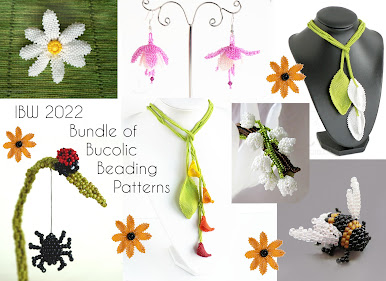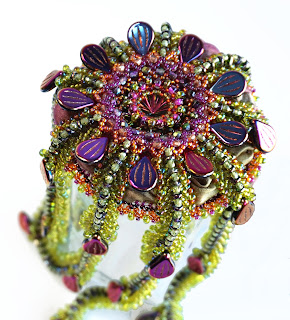Many people come to beading because something inside of them said “I can / want to do this too”. Then, after starting to gather information and learn to bead, they will show their first makes with pride. Then, after some playing and showing more, there might be occasions where they will hear “you need to give credit, you may not reverse engineer, you may not say that this is yours, you may not copy”. This results in loads of promising beaders abandoning our lovely Art form for another where things seem to be less complicated.
I am a designer who uses often geometric beadwork techniques. With the hope to show that it is not that complicated, I wrote this article about design collision, copying and copyright. It might, by far, not cover the whole subject, but I hope that it will answer many questions.
 |
The photo shown here is
one offered on www.pixabay.com,
free for all use, without attribution. |
We live in a world where spheres, aligned or placed in a certain manner can be seen as art. A photo of said spheres can also be
considered as being art. What is certain is that somebody made these
spheres, and someone made that photo, and they are entirely theirs until
they decide what one or more may do with them. Like selling the spheres
(to a public or private garden), or adding the photo where folks might
download it without restriction or even attribution, or sell it.
Golden rule: refrain from using something without consent unless clearly stated otherwise.
The
same applies to illustrations and texts in a magazine, book, or
tutorial. Even if the magazine or tutorial is a free download, it is
protected by copyright laws and only with the express consent of the
author can it be copied or scanned, shared or hosted elsewhere on the
Internet. Sites who publish other folks’ free patterns without consent
are frauds. Quotes are allowed as long as there is an attribution to the
author and the title of the publication.
What about beadwork?
It is a bit the same. I chose the example of the spheres because obviously, anyone can try to make spheres – it is a universal geometric form. Same for pyramids, cubes, and other geometric forms, made with triangles or other shapes which are primarily technique and where the actual designing resides rather in the color placement and motifs. Go make forms, but without copying all the beads in ABCDesigner’s beadwork. Do it your way.
 Now spheres and rings can be rather difficult to succeed. Go through the struggle of finding the right number of increases and beads. You will probably make the same form as others after all, but it will feel good to conquer it on your own.
Now spheres and rings can be rather difficult to succeed. Go through the struggle of finding the right number of increases and beads. You will probably make the same form as others after all, but it will feel good to conquer it on your own.
I started over 3 times to obtain a satisfying little round wreath for the earrings pictured above. The two other attempts failed because either the inside or the outside beads were competing for space, which resulted in wonky wheels. Try to make these earrings yourself without counting the number of beads used and see what happens. (No cheating!)
You want the exact same sphere as ABCDesigner? Buy the physical object. Or buy the tutorial. If none of these are available, ask the designer if he / she agrees that you make the same on your own. Some will say yes. Some will refuse. Accept that No is an answer and that you cannot have / own everything. Move on.
 |
| The photo above is one of DiMarca Online’s Peyote Ball designs. |
|
There are enough other beady delights out there to make and marvel at.
There are even groups on Facebook where you can bead for designers who
search for enthusiasts to test-bead their colourings.
You have a tutorial from another designer and wish to use elements from
it in your own creation? Make sure that it is ok to use (generally it
is), and give credit to the other designer for the element(s). The
beautiful star design on the left, by Helen McIntyre, illustrates this
well: the legs of her star come from Melanie de Miguel’s class teaching “Byzantine Cross”. Little changes were necessary to create the star, but
in its essence, it is Melanie’s cross with a 5th leg. Helen never made a
pattern for it because she doesn’t consider it as hers.
You wish to write a tutorial? Investigate before you do. It is a lot of work, and if it exists already, it will probably not sell. If you have a doubt, ask friends whom you can trust if they have seen it before? Kris Empting-Obenland posts photos of her new creations on Facebook and asks if it has already been made, because she doesn’t want to put so much time and effort in something that might already be available for purchase elsewhere.
 When I made my first warped square bail in 2008, shown in the photo
left, I was sure that I had invented something! In fact, I did, but I
wasn’t the only one. This comes from techniques being the same and the
beads having the same size. There is a “math” responsible for similar
results in form, especially geometric beadwork. If this happens to you
too, don’t be disappointed. You should always be proud of your own finds
and not give up making more things in your own sweet way. I still am
proud that I made a warped square bail on my own. The pendant is a
simplified version of a design called “Carré en Cage” designed the same
year by Belgian beader Marielle Baudoin.
When I made my first warped square bail in 2008, shown in the photo
left, I was sure that I had invented something! In fact, I did, but I
wasn’t the only one. This comes from techniques being the same and the
beads having the same size. There is a “math” responsible for similar
results in form, especially geometric beadwork. If this happens to you
too, don’t be disappointed. You should always be proud of your own finds
and not give up making more things in your own sweet way. I still am
proud that I made a warped square bail on my own. The pendant is a
simplified version of a design called “Carré en Cage” designed the same
year by Belgian beader Marielle Baudoin.
 |
Digital rendition of a Van Gogh painting
offered on www.pixabay.com,
free for all use, without attribution.
|
If you can copy something others made, be ethical. Many painters copy works by artists like Van Gogh, for example, as an exercise. They are not going to say that it is their painting! They often also pay for a canvas with instructions. If it is an interesting exercise or challenge, don’t brag on social media how clever you feel for having cracked someone’s design! You made something thanks to another person’s efforts and that’s all. Also, don’t let folks believe that it is your own. They will ask you to teach it. Don’t even think of teaching it. That might get you into trouble from a legal point of view. Try to make something new to really be proud of.
That said, when things get more complex, like our "further developments", then we are in a grey zone. Our work can be seen as half technique and half "what you do with it makes it unique". Another one might have done it, or be in the process of doing it. Or have done it differently.
In the grey zone we must play fair. If we make something after seeing someone else's work and base our new design on it, we need to give credit, perhaps even ask for permission, etc.
In the grey zone we need elegance of the mind, a kind heart, and honesty. If you know that you could not have made something without seeing or learning something from another designer, you need to give credit and ask for the other designer’s approval to teach.
 Helen McIntyre, whose geometric Cellini peyote work is well known, has been confronted with design collision due to the geometric properties of this stitch. For one of her best known Christmas decorations, shown on the left, she used a geometric shape and took it further. She transformed it into a much more elaborate design, but had to teach the basic shape to teach her design. However, she didn’t know who made the pattern of which she only had a small excerpt. She searched a long time and one day found me.
Helen McIntyre, whose geometric Cellini peyote work is well known, has been confronted with design collision due to the geometric properties of this stitch. For one of her best known Christmas decorations, shown on the left, she used a geometric shape and took it further. She transformed it into a much more elaborate design, but had to teach the basic shape to teach her design. However, she didn’t know who made the pattern of which she only had a small excerpt. She searched a long time and one day found me.
 We’ve had friendly conversations together, and it appears that she got a copy of a pattern for my Pepper earrings published in 2011 (photo right), for free, on the French forum HDPS.
We’ve had friendly conversations together, and it appears that she got a copy of a pattern for my Pepper earrings published in 2011 (photo right), for free, on the French forum HDPS.
I am delighted that she made such a beautiful new design with it and she got my permission to teach it.
Why? Well… to contribute to the evolution of the Art of Beading.
Claudia Furthner, who created the lovely Batcycle (and an incredible amount of delightful geometric beadwork) says the following:
“We are all Beavers! One beaver meets with another beaver, who shows him his dam full of pride. And the first one says Oh, I made one like that too yesterday.”
 |
Photos above: Bead Art by Claudia Furthner - Explorations with shapes and colour gradation. The triangles have an eye on one side and various colour blocks on the other side, which, placed in specific configurations, result in plenty of design possibilities.
|
Thank you for reading to the end!!
For those who like the Cellini peyote Pepper earrings, you may like my pattern for the 3 Cellini peyote shapes "Pepper, Fork & Yukka flower" or another of my 3D Cellini peyote patterns.
Bead happy and well.
Cath

















.jpg)











.JPG)






















